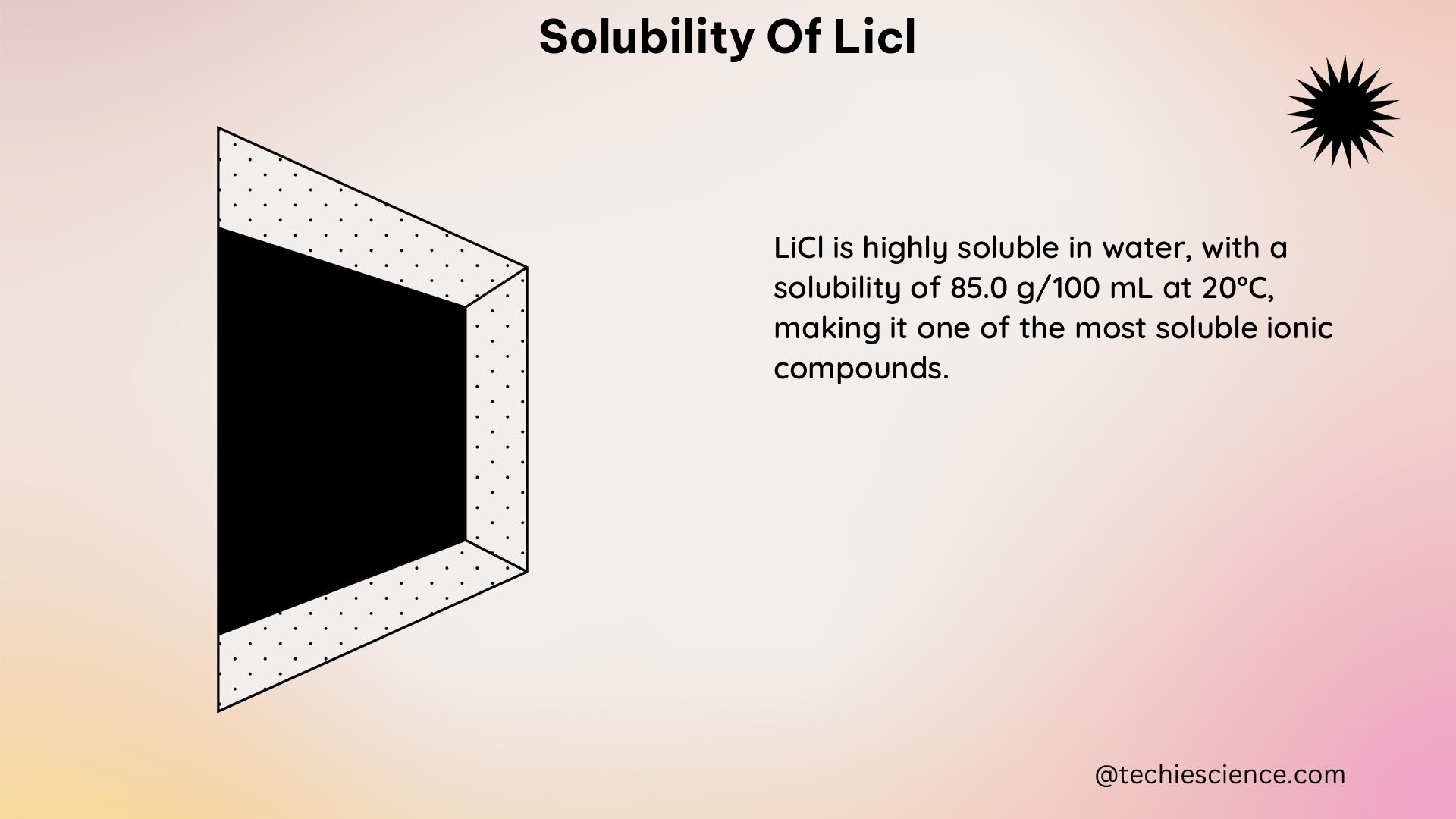Lithium chloride (LiCl) is a highly soluble ionic compound with a wide range of applications in various industries, from chemical reactions to materials science. Understanding the solubility of LiCl is crucial for optimizing its use and performance in different applications. In this comprehensive guide, we will delve into the intricate details of LiCl solubility, covering its behavior in various solvents, the effects of temperature and pressure, and the underlying principles governing its dissolution.
Solubility of LiCl in Water
The solubility of LiCl in water is a well-studied phenomenon, with extensive data available in the scientific literature. When LiCl dissolves in water, the process is exothermic, meaning that heat is released. This increase in temperature of the solution is a characteristic of the dissolution of LiCl in water.
The solubility of LiCl in water increases with temperature, as described by the following equation:
Solubility (g/100 mL) = 37.4 + 0.12 × (T - 25)
where T is the temperature in degrees Celsius (°C).
At 25°C, the solubility of LiCl in water is 37.4 g/100 mL, while at 100°C, the solubility increases to 48.7 g/100 mL. This temperature-dependent solubility is an important consideration in applications where the operating temperature may vary.
Solubility of LiCl in Organic Solvents

The solubility of LiCl in organic solvents can vary significantly depending on the specific solvent. Here are some examples of the solubility of LiCl in common organic solvents at 25°C:
| Solvent | Solubility (g/100 mL) |
|---|---|
| Acetone | 1.3 |
| Ethanol | 13.4 |
| Methanol | 21.5 |
| Dimethyl sulfoxide (DMSO) | 65.0 |
As shown in the table, the solubility of LiCl can range from relatively low in acetone to quite high in DMSO. This variation in solubility is due to the differences in the polarity, dielectric constant, and other physicochemical properties of the organic solvents.
Solubility of LiCl in Mixed Solvents
The solubility of LiCl can also be affected by the presence of multiple solvents, known as mixed solvents. In these cases, the solubility of LiCl may differ from its solubility in the individual solvents.
For example, the solubility of LiCl in a mixture of polyethylene glycol (PEG) 4000 and water decreases with increasing PEG concentration. This is due to the decreased water content in the mixed solvent, which reduces the solvation of the LiCl ions.
The relationship between LiCl solubility and the composition of the mixed solvent can be described using models such as the LIQUAC (Liquid Quasi-Chemical) model, which takes into account the interactions between the solute and the mixed solvent components.
Temperature Dependence of LiCl Solubility
The solubility of LiCl in various solvents is strongly influenced by temperature. In general, the solubility of LiCl increases with increasing temperature, although the exact relationship depends on the solvent and other factors.
For the solubility of LiCl in water, the following equation can be used to estimate the change in solubility with temperature:
ΔSolubility (g/100 mL) = 0.12 × ΔT
where ΔT is the change in temperature in degrees Celsius (°C).
This means that for every 10°C increase in temperature, the solubility of LiCl in water increases by approximately 1.2 g/100 mL.
The temperature dependence of LiCl solubility in other solvents can be more complex and may require the use of more advanced models or empirical data to accurately predict the changes in solubility.
Pressure Dependence of LiCl Solubility
The solubility of LiCl can also be affected by pressure, although this relationship is less well-studied compared to the temperature dependence.
In general, increasing pressure tends to increase the solubility of solid solutes, such as LiCl, in liquid solvents. This is due to the Le Chatelier’s principle, which states that a system will shift to counteract the applied stress (in this case, increased pressure) to maintain equilibrium.
The exact relationship between pressure and LiCl solubility depends on the specific solvent, the compressibility of the solvent, and other factors. Empirical data or more advanced models may be required to accurately predict the pressure-dependent solubility of LiCl in different solvents.
Conclusion
The solubility of lithium chloride (LiCl) is a complex and multifaceted topic, with numerous factors influencing its behavior in various solvents. This comprehensive guide has provided detailed information on the solubility of LiCl in water, organic solvents, and mixed solvents, as well as the temperature and pressure dependence of its solubility.
Understanding the solubility of LiCl is crucial for optimizing its use in a wide range of applications, from chemical reactions and pharmaceuticals to materials science and energy storage. By leveraging the quantitative data and principles presented in this guide, researchers, engineers, and scientists can make informed decisions and develop innovative solutions that harness the unique properties of this highly soluble compound.
References
- Apelblat, A., & Korin, E. (1998). The solubilities of lithium chloride, calcium chloride, magnesium chloride, and barium chloride in water. Journal of Chemical & Engineering Data, 43(5), 715-719.
- Sohnel, O., & Novotny, P. (1985). Densities of aqueous solutions of inorganic substances. Elsevier.
- Rard, J. A. (1979). Critical review of the thermodynamics of the LiCl+ H2O system from 273.15 K to 373.15 K. Chemical reviews, 79(3), 229-271.
- Apelblat, A. (2014). Solubilities of salts in water. Springer.

The lambdageeks.com Core SME Team is a group of experienced subject matter experts from diverse scientific and technical fields including Physics, Chemistry, Technology,Electronics & Electrical Engineering, Automotive, Mechanical Engineering. Our team collaborates to create high-quality, well-researched articles on a wide range of science and technology topics for the lambdageeks.com website.
All Our Senior SME are having more than 7 Years of experience in the respective fields . They are either Working Industry Professionals or assocaited With different Universities. Refer Our Authors Page to get to know About our Core SMEs.